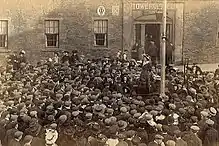Edith New | |
|---|---|
 by Peter Nairn of Hawick | |
| Born | Edith Bessie New 17 March 1877[1] |
| Died | 2 January 1951 (age 73) Liskeard, England |
| Known for | First suffragette vandal |
Edith Bessie New (17 March 1877 – 2 January 1951) was an English suffragette who was one of the first two suffragettes to use vandalism as a tactic. She and Mary Leigh were surprised to find their destruction was celebrated, and they were pulled triumphantly by lines of suffragettes on their release from prison in 1908.
Early life
She was born Edith Bessie New at 24 North Street, Swindon,[2] one of five children of Isabella (née Frampton; 1850–1922), a music teacher, and Frederick James New, a railway clerk, who died when Edith was less than a year old when he was hit and killed by a train. By age 14, she was working as a teacher, later moving to East London in 1901.[3][4]
Suffrage activism
In the early 1900s, New left her teaching career and began working as an organiser and campaigner for the Women's Social and Political Union (WSPU). She travelled around England, speaking to groups about the women's movement. In January 1908, New and Olivia Smith chained themselves to the railings of 10 Downing Street shouting "Votes for Women!", to create a diversion for their fellow suffragettes Flora Drummond and Mary Macarthur to sneak in before being arrested.[5] In June 1908, during a protest, New and another suffragette, Mary Leigh, broke two windows at 10 Downing Street. They were arrested and sentenced to two months in prison at Holloway.[6]

.jpg.webp)
It was the first time in the suffrage movement that vandalism had taken place. The women were at first concerned that other suffragettes would not approve of their actions, but Emmeline Pankhurst, a leader of the suffrage movement, visited the women in prison and gave them her approval for using vandalism as a tactic for getting their voices heard. Additional acts of vandalism and arson were planned by the women soon after.[7] During their court sentencing, the women threatened that next time they would use bombs. When they were released from prison in August 1908, a parade was held in their honour by a delegation of suffragettes that included Christabel Pankhurst.[8]
The WSPU presented Edith New with a Hunger Strike Medal 'for Valour' in recognition of her contributions to the suffrage movement. While in prison, she had gone on hunger strike in protest for the woman's right to vote.[9][10][11] In 1909, New was pictured in Hawick, Scotland addressing crowds outside the Tower Hotel. That year the WSPU and the rival NWSPU both took shops in Hawick and the police had to intervene when the crowd began to shake the speaker's carriage.[12] In 1911, New left the WSPU and moved to Lewisham to resume her teaching career.[13]
Later life and legacy

New retired to the small town of Polperro in Cornwall[13] and died in early 1951, aged 73.[11]
In 2011, a street in Swindon was renamed in her honour.[13] A Swindon Heritage blue plaque in North Street, Swindon, was installed on 19 March 2016 marking her birthplace.[14][15]
Portrayal in media
In the 2015 film Suffragette, a character partially based on New is portrayed by English actress Helena Bonham Carter.[16]
References
- 1 2 Amber Hicks (18 March 2016). "Plaque will mark Edith's birthplace". Swindon Advertiser.
- ↑ Bevan, Frances. "New, Edith Bessie". Oxford Dictionary of National Biography (online ed.). Oxford University Press. doi:10.1093/odnb/9780198614128.013.56249. (Subscription or UK public library membership required.)
- ↑ "Suffragettes: Edith New". Swindon Heritage. Archived from the original on 25 November 2015.
- ↑ Bevan, Frances (7 October 2009). "Suffragette jailed for votes battle". Swindon Advertiser. Retrieved 14 June 2015.
- ↑ Meeres, Frank (15 May 2013). Suffragettes: How Britain's Women Fought & Died for the Right to Vote. Amberley Publishing Limited. p. 30. ISBN 9781445620572.
- ↑ Haill, Lyn. "Votes for Women: A Timeline". Mary Neal Project. Retrieved 8 March 2019.
- ↑ Chandler, Malcolm (2001). Votes for Women, C.1900–28. Heinemann. p. 12. ISBN 9780435327316.
- ↑ "Mary Leigh and Edith New, the first suffragette window smashers". Museum of London. Retrieved 14 June 2015.
- ↑ Crawford, Elizabeth (2 May 2013). "Suffrage Stories: Mrs Alice Singer, Miss Edith New And The Suffragette Doll". Woman and Her Sphere. Retrieved 8 March 2019.
- ↑ "Where history happened: the fight for women's suffrage". History Extra. BBC. 15 June 2010. Retrieved 8 March 2019.(subscription required)
- 1 2 "Edith New". Biography.com. Archived from the original on 29 May 2018. Retrieved 8 March 2019.
- ↑ "Postcard reveals Hawick's role in suffragette fight". Hawick News. 12 August 2009. Retrieved 16 May 2018.
- 1 2 3 "Edith New: Remembering Our Forgotten Heroine". Swindon Heritage. Archived from the original on 22 September 2013. Retrieved 8 March 2019.
- ↑ "Swindon's first blue plaque unveiled to honour suffragette Edith New". Swindon Advertiser. 19 March 2016. Retrieved 8 March 2019.
- ↑ "Edith New: SUFFRAGETTE". SWINDON HERITAGE BLUE PLAQUES. Retrieved 4 March 2022.
- ↑ Erbland, Kate (15 April 2015). "Teaser for Suffragette will make you want to riot in streets, hang out with Meryl Streep". The Dissolve. Retrieved 8 March 2019.